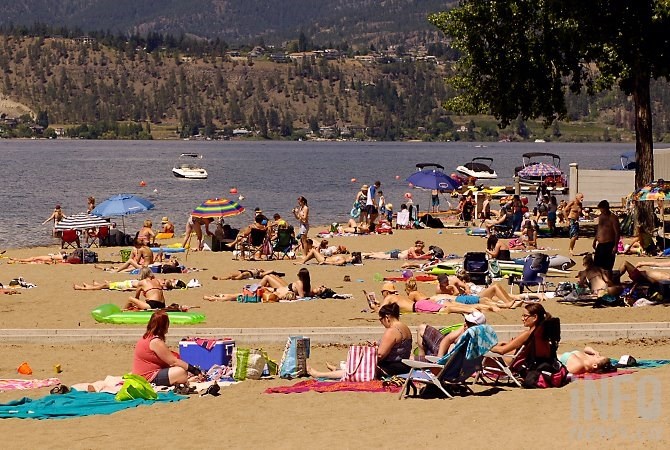
(ADAM PROSKIW / iNFOnews.ca)
July 26, 2021 - 11:51 AM
While it won’t get as hot as the record-breaking June heat dome that fried much of B.C., this week’s temperatures will reach the mid to high 30s in the Okanagan and Kamloops.
That means heat warnings are likely to be issued in the next day or two, Environment Canada meteorologist Doug Lundquist told iNFOnews.ca today, July 26.
“We want people to protect themselves from the heat, which means we need to look at and take care of the vulnerable people,” he said. “Know who doesn’t have air conditioning. Invite them in if they can’t cool off to your place or just check in on people. Make sure they’re hydrated and cooling down.”
Friday is forecast to be the hottest day in Kamloops at 37 C but that might be moderated by wildfire smoke in the area, Lundquist said.
The Okanagan is expected to hit 36 C on both Thursday and Friday.
“It might cool off towards the end of the long weekend into the low 30s but it’s just ridiculous – our high is 27 for this time of year, on average,” he said. “And, when I look to the long term, I didn’t see any big end to the heat and no relief for rain.”
The last time the region had a normal month for precipitation was back in December. Since then it’s been dry or extremely dry.
There is a slight chance of a millimetre or two of rain towards the end of the long weekend.
“That would probably come with a thunderstorm,” Lundquist said. “Any precipitation, especially if it’s a small amount, comes with lightning.”
It was thunderstorms on July 31-Aug. 1, 2018 that helped propel that year into a record setting season for wildfires, burning 1.35 million hectares in B.C.
Even a little bit of lightning can be dangerous because of how dry the forests are.
Ironically, in years with a higher number of thunderstorms, fewer wildfires are started. That’s because those storms generally bring a lot of rain with them.
When there’s only a little rain, that increases the chance that lightning will strike outside the “rain shaft” of the thunderclouds so there won’t be any accompanying rain to put those fires out.
To contact a reporter for this story, email Rob Munro or call 250-808-0143 or email the editor. You can also submit photos, videos or news tips to the newsroom and be entered to win a monthly prize draw.
We welcome your comments and opinions on our stories but play nice. We won't censor or delete comments unless they contain off-topic statements or links, unnecessary vulgarity, false facts, spam or obviously fake profiles. If you have any concerns about what you see in comments, email the editor in the link above.
News from © iNFOnews, 2021